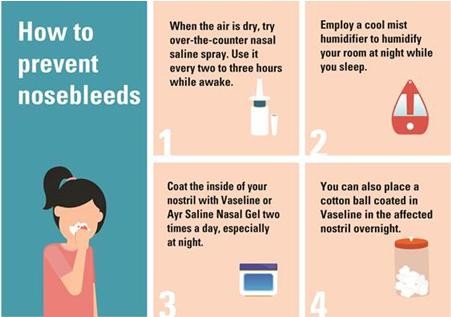Nosebleeds, also known medically as epistaxis, are a common occurrence, affecting approximately one in seven Americans at some point in their lives. Experiencing a bloody nose can be alarming, especially when it happens suddenly. However, it’s important to understand that most nosebleeds are not serious and can be managed effectively at home. Understanding the reasons behind a nosebleed can help you prevent them and know when to seek medical advice.
 Nosebleed illustration with pressure points
Nosebleed illustration with pressure points
Common Reasons for Nosebleeds
Several factors can contribute to nosebleeds. Often, they are related to simple environmental or lifestyle issues. Here are some of the most frequent causes:
Dry Air
One of the primary culprits, especially during winter months, is dry air. Whether it’s the low humidity of a dry climate or the dry indoor air caused by heating systems, dryness can irritate the delicate lining of your nose. This dryness can cause the nasal membranes to crack and become more susceptible to bleeding.
Nasal Irritation and Trauma
Anything that irritates the inside of your nose can lead to a nosebleed. This includes:
- Nose Picking: A very common cause, especially in children.
- Forceful Nose Blowing: Can rupture small blood vessels.
- Colds and Allergies: Nasal infections and allergies often cause inflammation and increased fragility of the nasal lining. Frequent nose blowing and sneezing associated with these conditions can also trigger bleeding.
- Steroid Nasal Sprays and Decongestants: While helpful for congestion, overuse can dry out and irritate the nasal passages, paradoxically increasing the risk of nosebleeds.
- Direct Injury to the Nose: Even minor bumps or injuries can cause the nose to bleed.
Medications
Certain medications can increase your likelihood of experiencing nosebleeds:
- Anticoagulants (Blood Thinners): Medications like aspirin, warfarin, and other blood thinners reduce the blood’s ability to clot. While crucial for preventing strokes and heart attacks in some individuals, they can also make nosebleeds more frequent and harder to stop.
Less Common but Notable Causes
While most nosebleeds are due to the reasons mentioned above, less frequently, they can be associated with other health conditions:
- High Blood Pressure: Hypertension can sometimes contribute to nosebleeds, although it’s not usually the primary cause. It’s more likely that high blood pressure will make a nosebleed harder to stop.
- Underlying Medical Conditions: Rarely, conditions that affect blood clotting or blood vessels can cause recurrent nosebleeds. Hereditary conditions affecting blood vessels are also a possibility, though less common.
What Should You Do When You Get a Nosebleed?
Knowing how to properly manage a nosebleed can minimize the mess and discomfort. Here’s a step-by-step guide based on medical recommendations:
- Stay Calm: It’s crucial to remain calm, as anxiety can sometimes worsen the bleeding.
- Lean Forward: Sit up and lean slightly forward. This position helps prevent you from swallowing blood, which can irritate your stomach and cause nausea or vomiting. Spit out any blood that accumulates in your mouth.
- Use a Decongestant Nasal Spray (Optional): Applying a decongestant nasal spray like Afrin into the bleeding nostril can help constrict blood vessels and slow down bleeding. Use 3 sprays in the affected side.
- Pinch Your Nose: Use your thumb and index finger to firmly pinch the soft lower part of your nose, just below the bony bridge. Make sure you are pinching the soft part where nosebleeds usually originate.
- Maintain Pressure for 10 Minutes: Time it with a clock or timer. Resist the urge to release pressure to check if the bleeding has stopped before the full 10 minutes have passed.
- Re-apply Pressure if Bleeding Continues: After 10 minutes, release the pressure. If your nose is still bleeding, soak a cotton ball with decongestant nasal spray, insert it into the bleeding nostril, and pinch again for another 10 minutes.
- Avoid Nose Blowing and Strenuous Activity: For at least 2 days after the nosebleed has stopped, avoid blowing your nose, heavy lifting, strenuous exercise, and bending over. This helps prevent re-bleeding.
- Check Your Blood Pressure: If you have a blood pressure monitor at home, check your blood pressure after the nosebleed. Elevated blood pressure can be a contributing factor.
When is a Nosebleed a Medical Emergency?
While most nosebleeds are manageable at home, there are situations when you should seek immediate medical attention. Go to the emergency room or seek urgent medical care if you experience any of the following:
- Unstoppable Bleeding: Bleeding that does not stop after 30 minutes of continuous, correctly applied pressure.
- Heavy Bleeding: If the blood flow is very heavy, such as pouring down the back of your throat even when leaning forward, or gushing out of your nose.
- Bleeding with Other Symptoms: Nosebleeds accompanied by other symptoms like chest pain, lightheadedness, rapid heart rate, or very high blood pressure may indicate a more serious underlying issue requiring immediate evaluation.
- Nosebleed After Injury: A nosebleed that occurs after a significant head injury may require medical assessment to rule out other problems.
- Frequent Nosebleeds: If you are experiencing nosebleeds more than 3-4 times a week, or more than 6 times a month, despite following self-care tips, you should consult your healthcare provider to determine the underlying cause and appropriate management.
Understanding why you might bleed from your nose and knowing how to respond can help you manage most nosebleeds effectively at home. However, it’s always wise to consult with a healthcare professional if you have concerns about the frequency, severity, or cause of your nosebleeds.